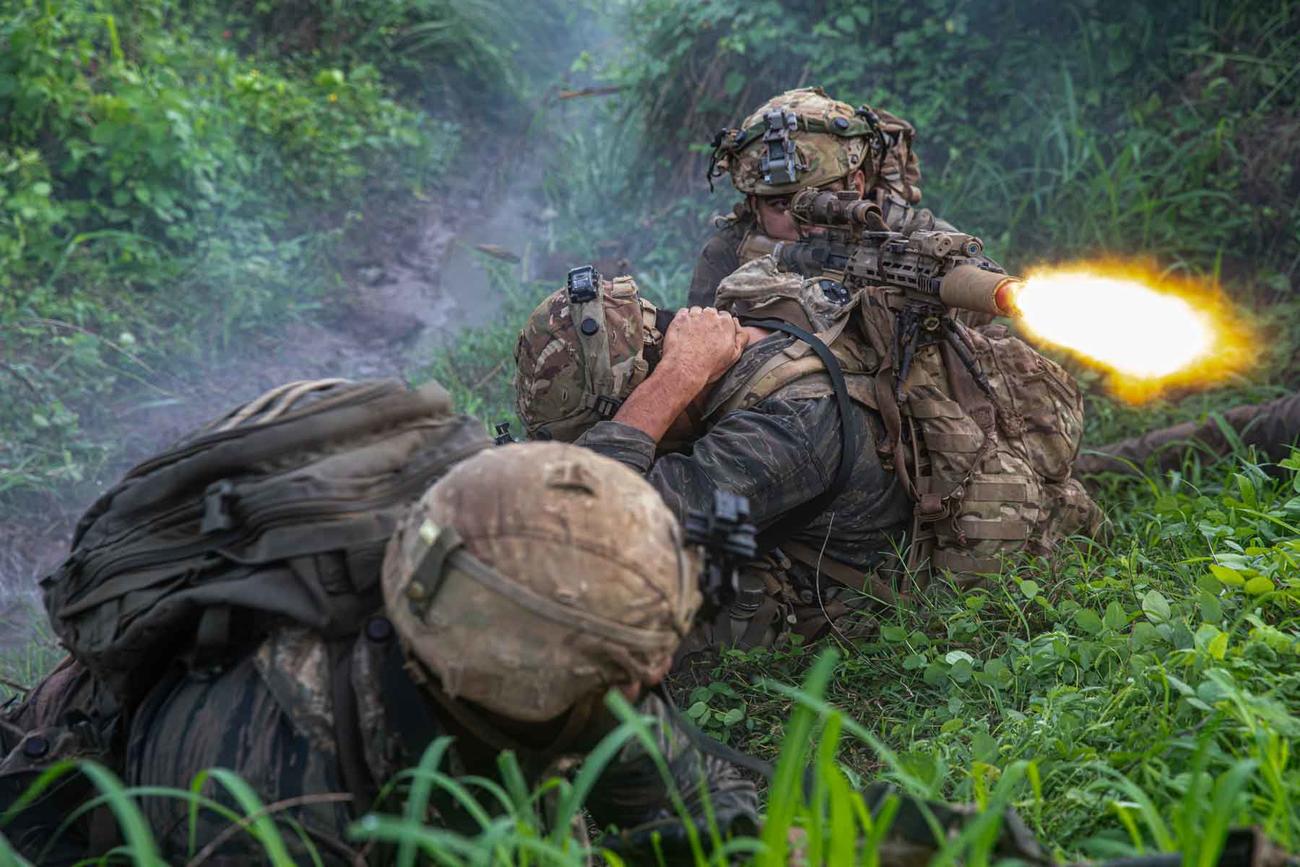

Hawaii-based Army units are continuing to play a central role in U.S.-Philippine relations as tensions mount between China and the Philippines.
On June 10, soldiers from the Schofield Barracks-based 25th Infantry Division, the Fort Shafter-based 196th Infantry Brigade and the Army Reserve’s 100th Infantry Battalion wrapped up Exercise Salaknib. The Army exercise was held in two parts, one that began in April and one in June—it was put on pause for the larger multinational Exercise Balikatan in May, in which the Hawaii troops also participated.
The latter half was run by soldiers from the 196th as part of the Army’s Joint Pacific Multinational Readiness Center, a series of training ranges in Hawaii and Alaska to prepare soldiers for Pacific deployments. The training in the Philippines was part of the 196th Infantry’s “exportable ” version called JPRMC-X, which does training annually in a different Pacific country each year.
Philippine troops have trained in the Hawaii JPMRC exercises in recent years and want to develop their own version. 196th brigade commander Col. Bryan Martin said, “They call it a ‘combat training readiness area, ’ and they’re trying to set one up … at Fort Magsaysay in Luzon, and it’s very much a model of JPMRC.”
The Philippine military has years of experience fighting rebel and terrorist groups across its islands, including the 2017 Battle of Marawi against Islamist Abu Sayyaf fighters aligned with ISIS. But Philippine officials say they are shifting their focus and resources to “territorial defense ” against outside threats—namely China.
Manila and Beijing have been locked in an ongoing territorial dispute involving several islands and reefs in the South China Sea in a region the Philippines calls the West Philippine Sea. In 2016 an international court ruled in the Philippines’ favor and declared that China’s territorial claims had “no legal basis, ” but the Chinese military doubled down. It has built bases on disputed islands and reefs and is frequently harassing and attacking vessels and fishermen from neighboring countries.
On June 17, members of the Chinese coast guard brandishing axes, machetes, knives and clubs boarded Philippine navy boats and confiscated equipment in a scuffle that left a Philippine navy sailor severely injured and minus one finger. According to Philippine officials, Chinese vessels rammed Philippine military boats to stop them from resupplying troops on the the BRP Sierra Madre, a beached vessel the Philippines has used as an outpost on the disputed Second Thomas Shoal.
The Philippine military’s shift away from fighting rebels and terrorists toward protecting its borders is a major change as well as a daunting challenge for the institution. Martin explained, “They have no bedrock experience, and their military has been very much internally focused on internal security operations for much of its history, with the exception of working alongside the U.S. military in the’40s (during World War II ).”
Now Filipino soldiers are training to fight a force potentially far more powerful than they have ever faced. Martin said that with JPMRC -X the goal is to “create an immersive environment that brings in all the pressures that combat against a peer adversary might bring. Or in their case, an adversary that’s infringed on their territorial sovereignty, and how do they hold them off until allies and partners can arrive to help reestablish sovereignty ?”
Much of the most bitter disputes in the region have been at sea, and American policymakers have traditionally regarded the Navy as the lead military force for Pacific strategies. The Oahu-based U.S. Indo-Pacific Command at Camp Smith always has been commanded by a Navy admiral. That’s led some policy analysts to question how much of a role, if any, the Army should play—and how much funding it should receive.
Gen. Charles Flynn, commander of U.S. Army Pacific, has been promoting the concept of a Pacific “landpower network ” and has sometimes frustrated his critics with his refrain, “People live on the land.”
In May at the Association of the U.S. Army’s Landpower in the Pacific Conference in Waikiki, Flynn told an audience of military leaders from around the world that “all branches of our militaries are dependent on land and will always return to land. Ships require ports, planes need airfields, satellites communicate with ground terminals, even cybereffects depend on terrestrial-based infrastructure.”
In 2023 the Philippine and U.S. governments announced expanded basing agreements that Marcos said would see U.S. troops “scattered around the Philippines—there are some in the north, there are some around Palawan, there are some further south.” Among other things, the Army recently began deploying a small detachment of soldiers rotating through the Philippines helping monitor Chinese “maritime militia ” activity in the South China Sea from the shore.
Not everyone in the Philippines has welcomed these closer ties. On May 9, as Exercise Balikatan came to a close, a group of activists that included the Filipino fishers group Pamalakaya protested outside of the Philippine military’s general headquarters Camp Aguinaldo as leaders hosted the exercise’s ending ceremony.
In 2023 Pamalakaya condemned the new basing agreements between the U.S. and Philippines, saying “our territorial waters in the West Philippine Sea are already militarized by China ; the last thing that Fili pino fishers want is an expansion of U.S. military bases at the further expense of our sovereign rights and territorial integrity.”
But the Philippine army is eager to continue working with American troops. Martin said, “We have a partner that is extremely eager to learn how to train, how to set up a combat training center to be a participant at all levels.”
___
(c)2024 The Honolulu Star-Advertiser
Visit The Honolulu Star-Advertiser at www.staradvertiser.com
Distributed by Tribune Content Agency, LLC.
© Copyright 2024 The Honolulu Star-Advertiser. All rights reserved. This material may not be published, broadcast, rewritten or redistributed.
